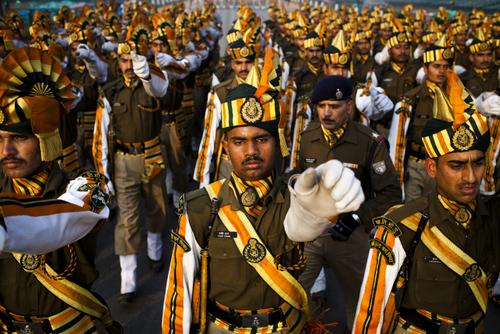India’s “masterly inaction” at heart of paper victory against insurgency
Indian soldiers practice their stunts on Royal Enfield motorcycles in preparation for the Republic Day parade on January 11, 2012 in New Delhi, India. Republic Day is celebrated every year on 26 January to commemorate the date and moment when the Constitution of India came into effect. It is marked by a grand parade in the capital New Delhi, with a show of force by the Indian military that starts from the Raisina Hill in the neighborhood of the majestic Rashtrapati Bhawan that passes along the Rajpath and ends at India Gate.
India's Republic Day parade is meant to celebrate the formation of one of the world's most intelligent, liberal and fair-minded constitutions. But it's really just a massive exercise in "my missile is bigger than yours."
Worse still, the country's biggest on-paper-only victories against its dozen-odd simmering insurgencies this year were actually accomplished by what the guys in the paan-stained buildings call "masterly inaction," according to Delhi-based writer Eric Randolph.
"Dramatic falls in insurgent and separatist violence across India seem to suggest something is actually going right for the government for a change," Randolph writes. "Kashmir, where separatist protests led to over 100 deaths in 2010, was relatively trouble-free last summer. Almost all the major rebel groups in India’s restive northeast are engaged in peace talks. Killings related to the Maoist insurgency – considered the 'gravest threat' of all by the government – fell by half from the previous year."
According to Foreign Policy:
India has had its share of insurgencies. In all, an estimated 30 armed insurgency movements are sweeping across the country, reflecting an acute sense of alienation on the part of the people involved. Broadly, these can be divided into movements for political rights (e.g. Assam, Kashmir and Khalistan [Punjab]), movements for social and economic justice (e.g. Maoist [Naxalite] and north-eastern states), and religious grounds (e.g. Laddakh). These causes overlap at times.
Randolph suggests we shouldn't consider them genuinely on the wane. Experts cite continued small-scale incidents and dysfunction all over the map from Kashmir to the Northeast to argue that the lull in the action trumpeted by the Home Ministry is just that: Terror fatigue.
And what the government may project as a Napoleonic decision not to interrupt the enemy while he's making mistakes is actually just indecision, or incompetence, or inefficiency.
As Randolph puts it: "What ultimately saves the republic is perhaps its sheer size and bewildering variety, which make it difficult for any one rebellion or issue to threaten the state as a whole. The government’s lumbering response – referred to as 'masterly inaction' in the corridors of power – can often appear effective."
